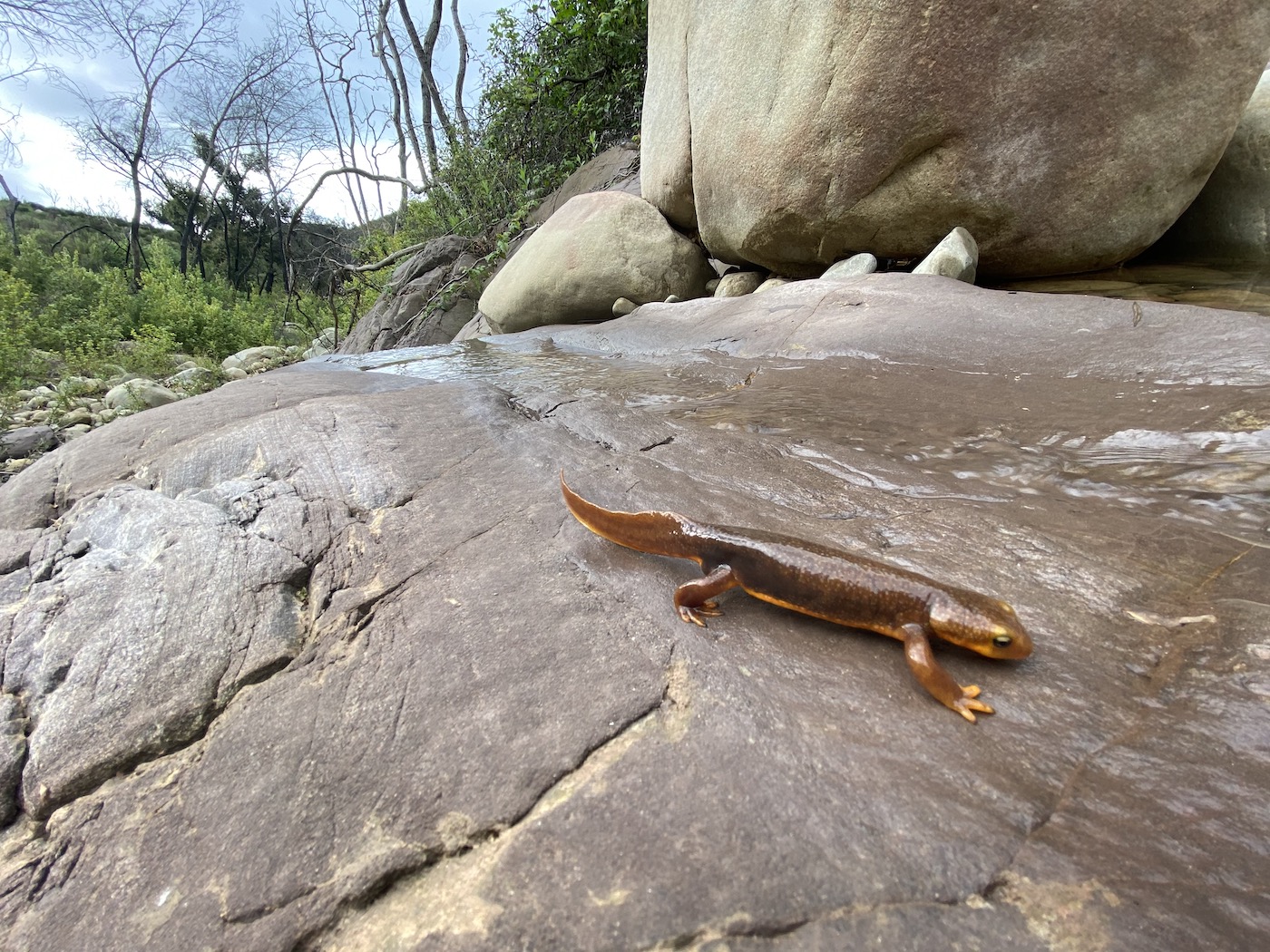Newtified

The creeks were flowing, spilling over a configuration of cobble that snaked their way to the Santa Clara River. As water pooled up and calmed California newts (Taricha torosa) gathered, the only endemic salamander species in the Golden State.
As I rock-hopped upstream, I found one of the orange-bellied newts out of the water, out of its comfort zone, working its way against the grain, an upper pool all to its own awaited. Moving slowly and awkwardly as if it had a hitch in its giddy-up, it finally found its aquatic haven diving in and swimming efficiently to a dark corner of the pool, its tail propelling crocodilian-like in the replenished creek.
Like Most Critters
It is all about habitat and like most critters it’s how bountiful that habitat is. In the case of California newts, they need suitable riparian environments possessing free-flowing creeks and streams. Clear ponds and pools with surrounding upland chaparral habitat are vital, with lots of mud and leaf litter in California’s coastal ranges.

California newts require moisture. Like most other amphibians species they spend winter and spring where water flows, but also a significant amount of time is spent out of water in summer and fall – the driest months of the year – buried in mud patiently waiting for the next significant rains.

Because much of their habitat has been altered in some capacity, these medium-sized, 5- to 8-inch-long salamanders possessing rough textured skin is listed as a California Species of Special Concern. And like so many endemic species, they have been forced to compete with introduced, nonnative species. The red swamp crayfish is a true threat to the existence of the California newt.
Initially introduced as fish bait, this aggressive crayfish species feasts on helpless California newt larvae and egg masses. The invasive crayfish also disrupts newt breeding cycles where aquatic space is vital. Breeding is aggressive enough with newts to let alone be harassed by antagonistic, introduced crayfish. Armed with sharp claws, California newt adults cannot defend themselves as they are mauled, disfigured and even killed by the red swamp crayfish. When both species are present in the same habitat, it is not uncommon to see California newts with portions of their tails gone missing.
Newt Scrum
As I carefully tiptoed along the cobbled creek, I hiked gingerly not to disturb California newts or anything else enjoying the recent, late winter rains. California newts blend in so well with their environment, and because they move slowly, methodically out of water, I did not want to step on one.
A decent sized pool emerged where at least 15 newts congregated in the shallows. A few swam effortlessly from end to end. Then, underneath some storm debris a tangled ball of newts swirled in the corner of the pool. King of the Pool? Newtmania? A family get together? Apparently, none of the above. Breeding ball of newts is something to behold. While observing several twisted balls of newts, it was difficult to count how many newts were actually taking pleasure in the mating scrum. They get so entangled some were hanging on for dear life to participate in what can be a mortal ending for the female newt.

I even watched a few newts hanging onto the tails of other newts that were already in favorable position to fertilize eggs, essentially the equivalent of climbing a rope or ladder to hop onboard and get a chance to sew their seeds of love. It does not look anything like love for the female though. In fact, some females do not survive the breeding ball. At times it looks like they are being strangled and suffocated in the water.
Generally, reproduction occurs from December through May. Amazing enough, adult newts find their way back to the pools they were hatched in. The 7 to 30 eggs appear like a thick gel and are attached to whatever is lodged within a pool: sticks, crevices within rocks and vegetation.
Once the breeding scrums have finished, some adult newts disperse. Others choose to stay close to home looking to feed for several months more.
Slow but Potent
The sleek, smooth-swimming, two-striped garter snake had its head out of the water. It seemed to be on the hunt. The look on its face was that of laser focus. It appeared menacing, intent on consumption. The water was clear, visibility was excellent as the serpent scoured all crevices within the three-foot-deep pond. Then there was a flash of movement. A Pacific green tree frog flinched, and the chase was on.
California newts are not the swiftest on land and would seem to be susceptible to predation, but as newts plod along they never fear. I certainly would never have thought a small, dawdling, seemingly defenseless amphibian could pack such a lethal punch, but they can.
Apparently, like other newt species the glands hidden within the rough skin on the back of a newt secretes neurotoxin tetrodotoxin, 100 times more lethal than cyanide. It is enough to kill any potential predator including us humans, but only if ingested. I cannot think of anyone that would skewer a newt and throw it on the barbeque, but stranger things have happened, meat lovers beware.
Having said all that, the California newt has very few natural predators except for one. There is always at least one. Over time, two-striped garter snakes have developed a resistance to the newt’s toxins, so the newts take their chances by land or water, never really looking over their shoulders but knowing concealment is their best defense.







